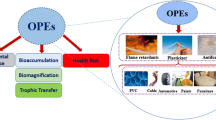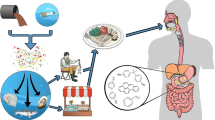Abstract
The composition of chlorophenols in marine organisms from the southern coast of Hangzhou Bay, China, was analyzed and the health risks posed to humans assessed. A total of 19 chlorophenols from 16 types of marine organism were analyzed across nine survey sections in Hangzhou Bay. The chlorophenols were analyzed by gas chromatography-mass spectrometry using a DB-5MS quartz capillary column. The concentrations of monochlorophenol, dichlorophenol, trichlorophenol, tetrachlorophenol, and pentachlorophenol ranged from below the detection limit (ND) to 132 μg/kg, ND–51.0 μg/kg, ND–42.5 μg/ kg, ND–69.0 μg/kg, and ND–9.06 μg/kg, respectively. Additionally, concentration differences between each type of chlorophenol were not significant (P>0.05). However, significant differences were found between monochlorophenol (F=8.13, P<0.01) and total chlorophenol (F=5.19, P<0.01) concentrations. As the noncarcinogenic risk indices were <0.1 (10-5–10-2) for all of the organisms, no high risk was posed by 2-chlorophenol, 2,4-dichlorophenol, 2,4,6-trichlorophenol, 2,4,5-trichlorophenol, 2,3,4,6-tetrachlorophenol, and pentachlorophenol to humans consuming marine organisms from the study area. Furthermore, the carcinogenic risks posed by 2,4,6-trichlorophenol and pentachlorophenol were lower than limits set by the International Commission on Radiological Protection and the US Environmental Protection Agency. However, the noncarcinogenic and carcinogenic risks posed by chlorophenols in marine organisms from four of the survey sections (Sizaopu, Niluoshan, Longshan Town and Xinhong zha) were higher than the other survey sections.
Similar content being viewed by others
References
Besser J M, Wang N, Dwyer F J, Mayer Jr F L, Ingersoll C G. 2005. Assessing contaminant sensitivity of endangered and threatened aquatic species: part II. Chronic toxicity of copper and pentachlorophenol to two endangered species and two surrogate species. Archives of Environmental Contamination and Toxicology, 48 (2): 155–165.
Buikema Jr A L, McGinniss M J, Cairns J. 1979. Phenolics in aquatic ecosystems: a selected review of recent literature. Marine Environmental Research, 2 (2): 87–181.
Capito B, Potter C, Edwards W. 1997. Comprehensive environmental response compensation and liability act (CERCLA) administrative record management system (ARMS) user’s guide. Revista Geologica de Chile, 35 (2): 279–305.
Chen H L, Yao J, Wang F, Zhou Y, Chen K, Zhuang R S, Choi M M F, Zaray G. 2010. Toxicity of three phenolic compounds and their mixtures on the gram-positive bacteria Bacillus subtilis in the aquatic environment. Science of the Total Environment, 408 (5): 1 043–1 049.
Cooper G S, Jones S. 2008. Pentachlorophenol and cancer risk: focusing the lens on specific chlorophenols and contaminants. Environmental Health Perspectives, 116 (8): 1 001–1 008.
Crosby D G. 2009. Environmental chemistry of pentachlorophenol. Pure and Applied Chemistry, 53 (5): 1 051–1 080.
Czaplicka M. 2004. Sources and transformations of chlorophenols in the natural environment. Science of the Total Environment, 322 (1–3): 21–39.
de Morais P, Stoichev T, Basto M C, Vasconcelos M T S D. 2012. Extraction and preconcentration techniques for chromatographic determination of chlorophenols in environmental and food samples. Talanta, 89 (2): 1–11.
Di Giulio R T, Washburn P C, Wenning R J, Winston G W, Jewell C S. 1989. Biochemical responses in aquatic animals: a review of determinants of oxidative stress. Environmental Toxicology and Chemistry, 8 (12): 1 103–1 123.
do Nascimento N R, Nicola S M C, Rezende M O O, Oliveira T A, Öberg G. 2004. Pollution by hexachlorobenzene and pentachlorophenol in the coastal plain of São Paulo State, Brazil. Geoderma, 121 (3–4): 221–232.
Dong J, Li X L, Luan T G, Zou S C, Lin L. 2009. Phenol pollution in the sediments of the Pearl River estuary area and its potential risk assessment to the eco-security. Journal of Safety and Environment, 9 (5): 113–116.
Dorsey W C, Tchounwou P B. 2004. Pentachlorophenolinduced cytotoxic, mitogenic, and endocrine-disrupting activities in channel catfish, Ictalurus punctatus. International Journal of Environmental Research and Public Health, 1 (2): 90–99.
Feng M. 2014. Study on Distribution, Eco-toxicological Effects and Health Risk Assessment of Chlorophenol Contaminants in Dongting Lake. China University of Geosciences, Beijing. p.1-37. (in Chinese)
Häggblom M M, Bossert I D. 2003. Halogenated organic compounds-a global perspective. In: Haggblom M M, Bossert I D eds. Dehalogenation: Microbial Processes and Environmental Applications. Kluwer Academic Publishers, Dordrecht, Netherlands. p.3-29.
Jiang Q T, Lee T K M, Chen K, Wong H L, Zheng J S, Giesy J P, Lo K K W, Yamashita N, Lam P K S. 2005. Human health risk assessment of organochlorines associated with fish consumption in a coastal city in China. Environmental Pollution, 136 (1): 155–165.
Jin X W, Zha J M, Xu Y P, Giesy J P, Richardson K L, Wang Z J. 2012a. Derivation of predicted no effect concentrations (PNEC) for 2, 4, 6-trichlorophenol based on Chinese resident species. Chemosphere, 86 (1): 17–23.
Jin X W, Zha J M, Xu Y P, Giesy J P, Wang Z J. 2012b. Toxicity of pentachlorophenol to native aquatic species in the Yangtze River. Environmental Science and Pollution Research, 19 (3): 609–618.
Johnson W W, Finley M T. 1980. Handbook of acute toxicity of chemicals to fish and aquatic invertebrates. In: US Dept Interior. Fish and Wildlife Service. Resource Publish, Virginia, United States. p.8-87.
Karci A. 2014. Degradation of chlorophenols and alkylphenol ethoxylates, two representative textile chemicals, in water by advanced oxidation processes: the state of the art on transformation products and toxicity. Chemosphere, 99 (3): 1–18.
Kondo T, Yamamoto H, Tatarazako N, Kawabe K, Koshio M, Hirai N, Morita M. 2005. Bioconcentration factor of relatively low concentrations of chlorophenols in Japanese medaka. Chemosphere, 61 (9): 1 299–1 304.
Liu H H, Xu Y J, Deng X X, Zhang X X, Zhang H W, Sun Y, Tian X H, Gong X H. 2013. Risk assessment of OCP S and PCB S in organisms in Laizhou Bay offshore areas, Bohai Sea. Oceanologia et Limnologia Sinica, 44 (5): 1 325–1 332. (in Chinese with English abstract)
Liu Q N. 2013. Study on pollution status and health risk assessment of molluscicides and byproduct in Dongting Lake. Hebei Normal University, Shijiazhuang. p.1-54. (in Chinese)
Luo Q, Zha J M, Lei B L, Xu Y P, Wang Z J. 2009. Review of the aquatic ecotoxicology and water quality criteria of three chlorophenols. Acta Scientiae Circumstantiae, 29 (11): 2 241–2 249.
Ma Y B, Han J, Guo Y Y, Lam P K S, Wu R S S, Giesy J P, Zhang X W, Zhou B S. 2012. Disruption of endocrine function in in vitro H295R cell-based and in in vivo assay in zebrafish by 2, 4-dichlorophenol. Aquatic Toxicology, 106-107: 173–181.
Meng X Z, Zeng E Y, Yu L P, Mai B X, Luo X J, Ran Y. 2007. Persistent halogenated hydrocarbons in consumer fish of China: regional and global implications for human exposure. Environmental Science and Technology, 41 (6): 1 821–1 827.
Metcalfe J L, Hayton A. 1989. Comparison of leeches and mussels as biomonitors for chlorophenol pollution. Journal of Great Lakes Research, 15 (4): 654–668.
Murcia M D, Gomenz M, Gomez E. 2007. Degradation of 4-chlorophenol using Pseudomonas putida. Journal of Chemical Engineering, 10: 2–4.
Murray H E, Ray L E, Giam C S. 1981. Analysis of marine sediment, water and biota for selected organic pollutants. Chemosphere, 10 (11-12): 1 327–1 334.
Olaniran A O, Igbinosa E O. 2011. Chlorophenols and other related derivatives of environmental concern: properties, distribution and microbial degradation processes. Chemosphere, 83 (10): 1 297–1 306.
Peng Y Q, Chen J H, Lu S Y, Huang J X, Zhang M M, Buekens A, Li X D, Yan J H. 2016. Chlorophenols in municipal solid waste incineration: a review. Chemical Engineering Journal, 292: 398–414.
Qiu J S, Zhong H Y, Zhu X Y, Sang W G, Duan Q Y, Chai L Y. 2016. Characteristics and ecological risk of selected chlorophenols in seawater of the south Hangzhou Bay. Marine Environmental Science, 35 (2): 231–236. (in Chinese with English abstract)
Rogers I H, Lecings C D, Lockhart W L, Norstrom R J. 1989. Observations on overwintering juvenile Chinook salmon (Oncorhynchus tshawytscha) exposed to bleached Kraft mill effluent in the Upper Fraser River, British Columbia. Chemosphere, 19 (12): 1 853–1 868.
Strenge D L, Chamberlain P J. 1995. Multimedia environmental pollutant assessment system (MEPAS ®): exposure pathway and human health impact assessment models. Bettelle Memorial Institute, Ohio, U.S. p.2.15-5.19.
Stringer R, Johnston P. 2001. Chlorine and the Environment: An Overview of the Chlorine Industry. Kluwer Academic Publishers, Dordrecht, Netherlands. p.14-38.
U.S. Environmental Protection Agency. 1992. Guidelines for Exposure Assessment Published on May 29, 1992. Federal Register, 57 (104): 22 888–22 938.
Vlastos D, Antonopoulou M, Konstantinou I. 2016. Evaluation of toxicity and genotoxicity of 2-chlorophenol on bacteria, fish and human cells. Science of the Total Environment, 551-552: 649–655.
Whelan G, Strenge D L, Droppo Jr J G, Steelman B L, Buck J W. 1987. The remedial action priority system (RAPS): mathematical formulations. Journal of the Australian Traditional-Medicine Society, 19 (1): 13–18.
Yang C F, Lee C M. 2008. Pentachlorophenol contaminated groundwater bioremediation using immobilized Sphingomonas cells inoculation in the bioreactor system. Journal of Hazardous Materials, 152 (1): 159–165.
Yin D Q, Hu S Q, Jin H J, Yu L W. 2003. Deriving freshwater quality criteria for 2, 4, 6-trichlorophenol for protection of aquatic life in China. Chemosphere, 52 (1): 67–73.
Zheng W W, Yu H, Wang X, Qu W D. 2012. Systematic review of pentachlorophenol occurrence in the environment and in humans in China: not a negligible health risk due to the re-emergence of schistosomiasis. Environment International, 42: 105–116.
Zhong H Y, Liu H, Chai L Y, Zheng D, Yang J F, Qiu J S, Qiu J Q. 2016. Determination of 19 chlorophenols and their sodium salts by gas chromatography-mass spectrometry in aquatic products. Journal of Analytical Science, 32 (3): 371–376. (in Chinese with English abstract)
Acknowledgement
The authors wish to thank the many colleagues that assisted with the collection and analysis of marine organism samples.
Author information
Authors and Affiliations
Corresponding author
Additional information
Supported by the National Special Research Fund for Non-Profit Sector (Agriculture) (No. 201303047) and the Key Programs for Science and Technology Development of Ningbo, China (No. 2013C11027)
Rights and permissions
About this article
Cite this article
Zheng, D., Jiao, H., Zhong, H. et al. Chlorophenols in marine organisms from the southern coast of Hangzhou Bay, China, and an assessment of risks posed to human health. J. Ocean. Limnol. 36, 726–737 (2018). https://doi.org/10.1007/s00343-018-7039-3
Received:
Accepted:
Published:
Issue Date:
DOI: https://doi.org/10.1007/s00343-018-7039-3




